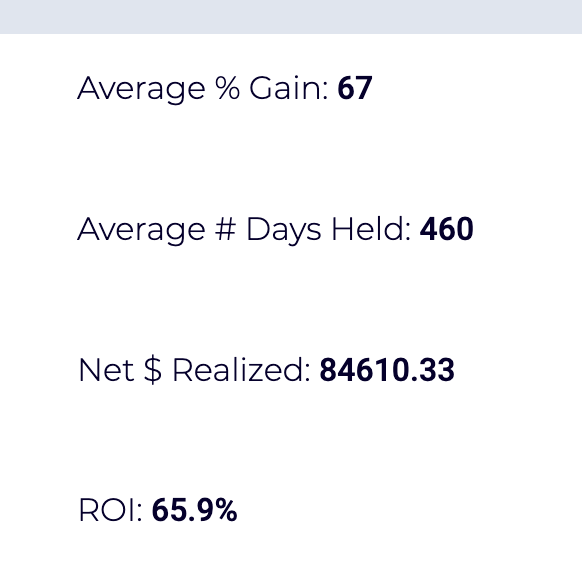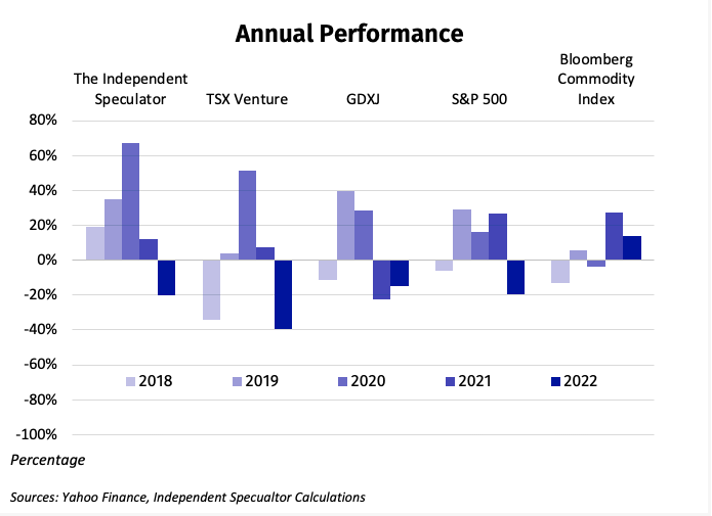I get asked from time to time why I don’t publish annual gains. People want to compare my results to “the market,” various indices, or other stock-pickers.
My answer has always been that annual snapshots are not realistic. Nobody buys on January 2 and sells on December 31 every year. I’m not a day trader. The Independent Speculator is not a trading service, but guidance for value-speculators willing to buy and hold until the speculation delivers or fails. The current average length of my completed speculations is 460 days. A stock’s performance over a calendar year is an arbitrary snapshot of no real importance.
What matters is whether or not we make money when a speculation is done.
This is why The Independent Speculator track record doesn’t have any annual breakdowns. It simply shows all completed trades, from beginning to end.
These are real trades, by the way, not theoretical or “model” portfolio positions. My track record includes screenshots of my brokerage orders. The results include all commissions and fees.
My track record shows the actual amounts of money I deployed and realized, currently showing an average gain of 67% and total return on investment of 65.9%.

But people keep asking for annual results… and I confess to some curiosity about how I compare to the indices.
Is Warren Buffett right about stock-pickers like me?
Should I just bet on an index fund?
To answer, we’ve come up with an unaudited annual report card for your amusement. Cutting to the chase, here’s how The Independent Speculator has done on a yearly basis since inception in 2018:
- 2018: 19%
- 2019: 35%
- 2020: 67%
- 2021: 12%
- 2022: -20%
This averages to 23% per year.
(That’s a lot less than the average of completed trades because I usually sell when I’m ready to book a win and move on—not to mention that 2022 was a tough year.)
I want to stress again that these results are not real.
These annual performance figures are purely theoretical gains. They’re based solely on:
- The prices at which my stock picks started a year (or the price I paid buying them during the year, or the cost basis if I averaged down in that year).
- The prices at which my stocks ended the year (or the price I got for selling them during the year).
These figures include no commissions or fees. They do not account for free spinout shares received, private placement warrants, or profit-taking. There’s no weighting. These are just plain-Jane yearly price gains, averaged for all positions.
I should also stress again that these figures are not audited. I’m not going to post the data they’re based on to the public. That would give away my current portfolio. In due course, as I close the trades, I will post them to my track record available to the broader public. It should be possible for anyone so inclined to verify my numbers.
A skeptical reader is invited to disregard these results completely and go by my public track record only.
So…
Did I beat the market?
For most years, for the most-relevant indices—including the GDXJ, a junior mining stock index, and the Toronto Venture Exchange, where most of my stocks trade—the answer is yes, I beat the market.
The chart below also includes the S&P 500, representing the broader markets, and the Bloomberg Commodities Index, representing commodities including minerals.

A striking and important aspect of this is that commodities did better than resource stocks over the last two years—especially in 2022. I see this as a mispricing and a great source of opportunity. I expect resource stocks to recover their usual leverage to their underlying commodities.
No one can say for sure, but I think re-valuation of the best mining stocks will happen this year, or next, if it takes the Fed that long to pivot.
Be that as it may, I can now cite numbers when people ask me for annual performance stats on my speculative investments.
Happily, I can say that at least so far, I’ve beaten the markets more often than not.
![]()
P.S. To be kept abreast of more dangers, opportunities, and issues affecting investors, please sign up for our free, no-hype, no-spam, weekly Speculator’s Digest.

